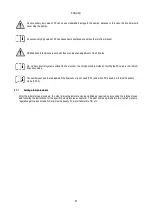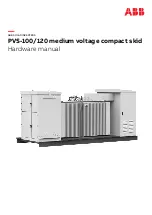
ENGLISH
111
6.6.8.2
NC: Simultaneous inverters
This sets the maximum number of inverters that can operate simultaneously.
It can be set with a value from 1 to NA. By default NC is set with the value NA; this means that whatever increase applied to NA, NC
is always set with the value of NA. If a different value from NA is set, the system sets to the set maximum number of simultaneous
inverters. This parameter is used when there is a limited number of pumps to be kept in operation (see IC: Configurazione della riserva
section 6.6.8.3 and the following examples).
In the same menu page, the user can view (without the option of modification) a further two system parameters related to this value,
i.e. N, the number of inverters detected automatically by the system, and NA, the number of active inverters.
6.6.8.3
IC: Reserve configuration
This configures the inverter as automatic or reserve. If set to auto (default) the inverter participates in the normal pumping process; if
configured as reserve, it is assigned with minimum start-up priority, i.e. this inverter will be the last to start up. If the number of active
inverters setting is lower of one unit than the number of inverters present and one element is set as reserve, this means that in normal
operating conditions the reserve inverter does not participate in normal pumping operations; otherwise if there is a fault on one of the
active inverters, (power supply failure, safety device trip etc.) the reserve inverter is started up.
The reserve configuration status can be checked as follows: in the SM page, the upper section of the icon is coloured; in the AD and
main pages, the communication icon representing the inverter address is displayed with the number on a coloured background. There
may be more than one inverter configured as reserve in a pumping system.
Inverters configured as reserve, even though not part of the normal pumping process, are still kept efficient by means of the anti-
stagnant algorithm. The anti-stagnant algorithm envisages, once every 23 hours, the exchange of start-up priority, to ensure that each
inverter accumulates at least one minute of continuous flow. This algorithm aims at avoiding deterioration of the water in the impeller
and to maintain efficiency of moving parts; it is useful for all inverters and in particular for the inverters configured as reserve, which
do not operate in normal conditions.
6.6.8.3.1
Examples of configuration for multi-inverter systems
Example 1:
A pump set comprising 2 inverters (N=2 detected automatically) of which 1 is set as active (NA=1), one simultaneous (NC=1 or NC=NA
provided that NA=1) and one as reserve (IC=reserve on one of the two inverters).
The effect is as follows: the inverter not configured as reserve starts up and runs alone (even if it cannot withstand the hydraulic load
and the pressure is too low). In the event of a fault, the reserve inverter is started up.
Example 2:
A pump set comprising 2 inverters (N=2 detected automatically) of which all inverters are active and simultaneous (default setting
NA=N and NC=NA) and one as reserve (IC=reserve on one of the two inverters).
The effect is as follows: the inverter not configured as reserve always starts up first; if the pressure reached is too low, the second
inverter, configured as reserve, also starts up. In this way, the use of one inverter in particular is preserved (the inverter configured as
reserve), but is always available as a support when necessary in the event of increased hydraulic loads.
Example 3:
A pump set comprising 6 inverters (N=6 detected automatically) of which 4 are set as active (NA=4), 3 simultaneous (NC=3) and 2 as
reserve (IC=reserve on two inverters).
The effect is as follows: a maximum of 3 inverters start up simultaneously. Operation of the 3 inverters enabled for simultaneous mode
is implemented in rotation between the 4 inverters to remain within the maximum operating time of each ET. In the event of a fault on
one of the active inverters, no reserve unit is started up as no more than three inverters can be started up at a time (NC=3) and there
are still three active inverters present. The first reserve unit intervenes only when one of the remaining three has a fault; the second
reserve is started up when another of the three (including the first reserve) has a fault.
6.6.9
ET: Exchange time
This sets the maximum continuous operating time of an inverter within a group. It is only applicable on pump sets with interconnected
inverters (link). The time can be set to between 10 s and 9 hours, or to 0; the factory setting is 2 hours.
When the time ET of an inverter has elapsed, the system starting order is re-assigned so that the “expired” inverter is set to minimum
priority. This strategy aims at reducing use of the inverter that has already been in operation, and to balance operating times of the
Summary of Contents for MCE-150/P
Page 308: ...306 IEC 60634 1...
Page 309: ...307 1 6 1 1...
Page 312: ...310 1 2 1 1 1 1 2 5 2 1 2 1 2...
Page 313: ...311 2 1 1 2 1 2 L L L 2 2 4 2 15 2 2 1 1a...
Page 314: ...312 2a 3a 4b 1b 127 240 240 480...
Page 318: ...316 GP GI 6 6 4 6 6 5 7 A B C D...
Page 323: ...321 50 60 7 DC AC 50 60 8 6 2 1 5 36 36 12 3 3 3 3 2 13 9 10 8...
Page 325: ...323 I1 F1 I1 6 6 13 2 I2 P2 6 6 13 3 I3 F3 6 6 13 4 I4 1 F4 6 6 13 5 10 GND 7 I1 I2 I3 I4...
Page 326: ...324 3 13 64 X 128 4 MODE SET 11 SET 9 MODE 1 SET 11 3 EEprom SET 6 SET MODE 3 1 11...
Page 327: ...325 3 2 1 2 3 2 1 MODE SET MODE 10 2 2 5 5 5 2 2 12...
Page 329: ...327 12 SET 14 15 13 15 3 3...
Page 331: ...329 15 14 3 4 PW 6 6 16 GO SB...
Page 332: ...330 4 4 1 Link 8 4 2 4 2 1 Link Link 15...
Page 333: ...331 17 Link 4 2 2 0 5V 4 20 A 0 4 2 2 1 FI FI 4 2 2 2 FZ 6 5 9 1 4 2 2 3 0 5 4 20 A 0 5 0...
Page 336: ...334 4 4 2 2 4 2 5 4 5 ET 6 6 9 FL 4 5 1 4 5 1 1 ET ET ET ET 0 ET 6 6 9 4 5 1 2 23 23...
Page 339: ...337 FZ FZ 2 35 FZ 37 FZ FZ FZ FZ FI 0 FZ FZ 0 5 1 7 6 GI GP FL TB...
Page 362: ...360 OC 10 6 OF 10 6 33 8 8 1 PMW 4 2 8 2 8 3 8 3 SET EE EEprom FLASH...
Page 548: ...546 IEC 364 1 inverter...
Page 549: ...547 1 Inverter inverter inverter 6 inverter 1 1...
Page 552: ...550 1 2 1 1 inverter inverter 1 1 2 5 inverter inverter 2 1 inverter inverter 2 1 2 C...
Page 554: ...552 2a 3a 4b...
Page 558: ...556 GP GI 6 6 4 6 6 5 inverter 7 A B C D...
Page 567: ...565 3 2 1 2 3 2 1 MODE SET Setpoint MODE 10 ONOMA TOY MENOY 2 Setpoint 2 5 5 5 2 2 12...
Page 571: ...569 15 15 14 3 4 Password inverter password password inverter password PW 6 6 16 GO SB FAULT...
Page 728: ...726 IEC 364 1 1...
Page 729: ...727 1 1...
Page 732: ...730 1 2 1 1 1 2 5 2 1 2 1 2 C...
Page 733: ...731 2 1 1 0 2 1 2 L L L 2 2 4 2 15 2 2 1 1...
Page 734: ...732 2a 3a 4b...
Page 738: ...736 GP GI 6 6 4 6 6 5 7 2 2 3 2 Press Flow 6 A B C D...
Page 743: ...741 DC AC 50 60 Hz 7 DC V AC 50 60 Hz Vrms V 8 6 V 2 1 5 V 36 36 12V A 3 3 3 3 2 13 8 10 8...
Page 744: ...742 12 J5 I1 11 17 16 18 16 17 I2 11 15 16 18 15 16 I3 11 14 13 18 13 14 I4 11 12 13 8 12 13 9...
Page 746: ...744 3 13 Oled 64 X 128 4 MODE SET 11 SET or 9 MODE 1 SET 10 3 EEprom SET SET or MODE...
Page 751: ...749 14 14 3 4 PW 6 6 16 GO SB FAULT...
Page 752: ...750 4 4 1 Link 8 4 2 4 2 1 Link Link 15...
Page 966: ...964 IEC 60634 1...
Page 967: ...965 1 6 1 1...
Page 970: ...968 1 2 5 2 1 2 1 2 2 1 1...
Page 971: ...969 2 1 2 L L L 2 2 4 2 15 2 2 1 1a 1a...
Page 976: ...974 3 2 2 3 2 Press Flow 6 A B C D...
Page 981: ...979 50 60 7 DC AC 50 60 8 6 2 1 5 36 36 12 3 3 3 3 2 13 2 10 8...
Page 982: ...980 5 J5 I1 11 17 16 18 16 17 I2 11 15 16 18 15 16 I3 11 14 13 18 13 14 I4 11 12 13 8 12 13 8...
Page 984: ...982 SET 9 3 EEprom SET 6 SET MODE 3 1 11 3 2 1 2 3 2 1 MODE SET MODE 10 2 2 5 5...
Page 986: ...984 4 3 2 2 12 SET 7 15 13...
Page 987: ...985 8 3 3 psi 12 GO SB BL LP HP EC...
Page 989: ...987 PW 6 6 16 4 4 1 Link 8 4 2 4 2 1 Link Link 15...
Page 993: ...991 4 4 2 2 4 2 5 4 5 ET 6 6 9 FL 4 5 1 4 5 1 1 ET ET ET ET 0 ET 6 6 9 4 5 1 2 23 23...
Page 1020: ......
Page 1021: ......
Page 1022: ......
Page 1023: ......
















































